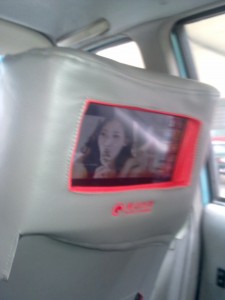Shanghai Street View: Taxi Trauma

Shanghai media have been buzzing these past few weeks about the dangers posed by advertising screens in the back seats of most city taxis, after a woman was critically injured when her head slammed into one such screen during a traffic accident. Local readers will instantly recognize the screens I’m talking about, as they’ve become an unpleasant fixture in 60 percent of Shanghai cabs, bombarding backseat passengers with nonstop advertisements from the moment they step in the taxi. The latest media reports say the company that operates the screens has developed a curtain to place around their borders, which would soften the impact on passengers in future similar crashes. But the better solution would be to completely get rid of these screens, which have become a major blemish on Shanghai’s image as it tries to become more international.
From a broader perspective, the controversy involving these screens reflects a much bigger blight that has infected much of China as it makes the transition from a socialist to market-oriented economy. That phenomenon has seen advertisements take over nearly any and every conceivable surface in public spaces, with the result that people are assaulted with ads on buses and subways, in supermarkets and convenience stores and even in their own apartment buildings.
Before I continue with my rant against the ads, let’s quickly recap what happened to spark this latest controversy. It all began when a cab crashed last month, hurling one of its passengers into the TV screen mounted on the backside of the front passenger seat. The passenger, a 24-year-old woman, suffered broken bones in her eye socket and nose, and had to be placed in intensive care for treatment. She wasn’t wearing a seat belt at the time, but most reports said the severity of her injuries was a direct result of slamming into the hard LCD surface in front of her.
The accident sparked a heated debate in Shanghai about the wisdom of allowing screens to be mounted in the back seats of taxi cabs. While consumer advocates voiced concerns over safety, cab companies and drivers said rental fees from the screens were necessary to supplement their income that was being eroded by rising gas prices.
In the latest twist of this taxi tale, the company that operates these annoying screens has unveiled a protective curtain designed to cushion the blow to a passenger’s head in case of an accident. The effectiveness of these curtains is still being evaluated, and I’m sure we’ll see several more chapters to this story before it reaches conclusion. But my more drastic solution to the problem is to simply remove these screens once and for all.
As a longtime China resident, I’ve seen the steady rise of these annoying advertising screens over the last 2 decades, fueled by the country’s rapid economic growth and a capitalistic spirit unparalleled in the west. When I lived in Los Angeles in the 1990s, I recall a case where a major brouhaha broke out over a single billboard. In that instance, the building owner erected the billboard on the side of his property, triggering a major backlash from local residents who called it an eyesore and said it violated city laws.
By comparison, one seldom hears of any resistance or complaints about the rapid proliferation of such eyesores in China. During my days as a foreign correspondent in China, I reported on a series of start-up companies that made big money by erecting advertising screens in almost any venue imagineable, from elevators, to grocery stores isles and apartment building lobbies. Many of those companies were later consolidated into a company called Focus Media, which suitably enough is actually based here in Shanghai, China’s commercial capital.
But while Shanghai may be China’s capital of commercialism, the crown for ugly and prolific advertisements is certainly one the city should try to avoid. Most importantly, such ads detract from the quality of life. No one wants to see commercials for laundry detergent blasted in their face in their office or apartment lobby at the end of a long working day. Likewise, the thought of having to face one of these screens during a 10-15 minute taxi ride is also a major turn-off for many.
If Shanghai is smart, it should take the opportunity of this unfortunate accident to rid the city of these annoying screens that now confront passengers in most of the city’s 30,000 cabs. Taxi drivers may complain, and perhaps even a small fare increase would be necessary to help offset their lost revenue. But at the end of the day, removal of these screens and other nuisance ads would make Shanghai just a tad friendlier for both residents and visitors, polishing its image as a modern, clutter-free city.
